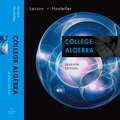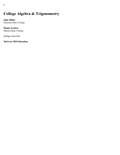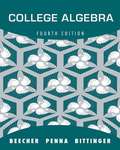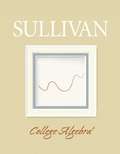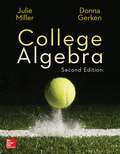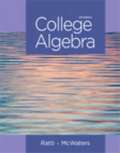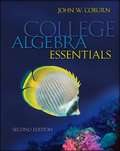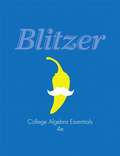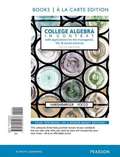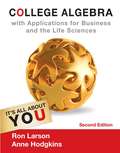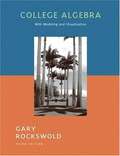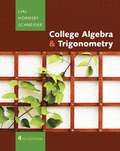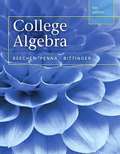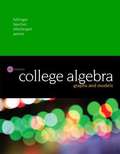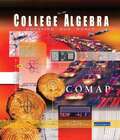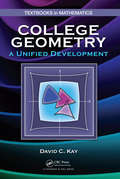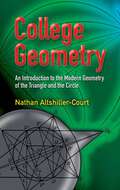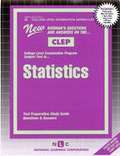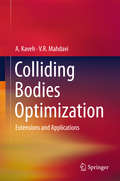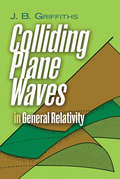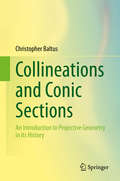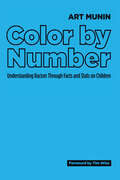- Table View
- List View
College Algebra
by Ron Larson Robert HostetlerThis market-leading text continues to provide students and instructors with sound, consistently structured explanations of the mathematical concepts. Designed for a one-term course that prepares students for further study in mathematics, the new Seventh Edition retains the features that have always made College Algebra a complete solution for both students and instructors: interesting applications, pedagogically effective design, and innovative technology combined with an abundance of carefully developed examples and exercises.
College Algebra (4th Edition)
by Marvin L. Bittinger Judith A. Beecher Judith A. PennaBeecher, Penna, and Bittinger's College Algebra is known for enabling students to "see the math" through its focus on visualization and early introduction to functions. With the Fourth Edition, the authors continue to innovate by incorporating more ongoing review to help students develop their understanding and study effectively. Mid-chapter Review exercise sets have been added to give students practice in synthesizing the concepts, and new Study Summaries provide built-in tools to help them prepare for tests. The MyMathLab course (access kit required) has been expanded so that the online content is even more integrated with the text's approach, with the addition of Vocabulary, Synthesis, and Mid-chapter Review exercises from the text as well as example-based videos created by the authors.
College Algebra (8th edition)
by Michael SullivanThe Eighth Edition of this highly dependable book retains its best features--accuracy, precision, depth, and abundant exercise sets--while substantially updating its content and pedagogy. Striving to teach mathematics as a way of life, Sullivan provides understandable, realistic applications that are consistent with the abilities of most readers. Chapter topics include Graphs; Polynomial and Rational Functions; Conics; Systems of Equations and Inequalities; Exponential and Logarithmic Functions; Counting and Probability; and more. For individuals with an interest in learning algebra as it applies to their everyday lives.
College Algebra (Collegiate Math)
by Julie Miller Donna Gerken<p>When Julie Miller began writing her successful developmental math series, one of her primary goals was to bridge the gap between preparatory courses and college algebra. For thousands of students, the Miller/O’Neill/Hyde (or M/O/H) series has provided a solid foundation in developmental mathematics. With the Miller College Algebra series, Julie has carried forward her clear, concise writing style; highly effective pedagogical features; and complete author-created technological package to students in this course area. The main objectives of the college algebra series are three-fold: <p> <li>Provide students with a clear and logical presentation of the basic concepts that will prepare them for continued study in mathematics. <li>Help students develop logical thinking and problem-solving skills that will benefit them in all aspects of life. <li>Motivate students by demonstrating the significance of mathematics in their lives through practical applications.</li> </p>
College Algebra (North Florida Community College)
by Ronald J. Harshbarger Lisa S. YoccoThe text is application-driven and uses real-data problems that motivate interest in the skills and concepts of algebra. Modeling is introduced early, in the discussion of linear functions and in the discussion of quadratic and power functions. Additional models are introduced as exponential, logarithmic, logistic, cubic, and quartic functions are discussed. Mathematical concepts are introduced informally with an emphasis on applications. Each chapter contains real-data problems and extended application projects that can be solved by students working collaboratively. The text features a constructive chapter-opening Algebra Toolbox, which reviews previously learned algebra concepts by presenting the prerequisite skills needed for successful completion of the chapter. In addition, a section on calculus preparation at the end of the text emphasizes how students can use their new knowledge in a variety of calculus courses.
College Algebra (The Lial Hornsby Schneider College Algebra Series)
by Margaret L. Lial John Hornsby David I. Schneider Callie J. DanielsOver the years, the text has been shaped and adapted to meet the changing needs of both students and educators. As always, special care was taken to respond to the specific suggestions of users and reviewers through enhanced discussions, new and updated examples and exercises, helpful features, and an extensive package of supplements and study aids. The result is an easy-to-use, comprehensive text that is the best edition yet.
College Algebra (Third Edition)
by J. S. Ratti Marcus S. McwatersRatti and McWaters have combined years of lecture notes and classroom experience to bring you a series that connects concepts and maintains course rigor. An extensive array of exercises and learning aids further complements your instruction, which ultimately helps to improve student mathematical understanding and results in the course.
College Algebra Essentials
by John W. CoburnThree components contribute to a theme sustained throughout the Coburn Series: that of laying a firm foundation, building a solid framework, and providing strong connections. Not only does Coburn present a sound problem-solving process to teach students to recognize a problem, organize a procedure, and formulate a solution, the text encourages students to see beyond procedures in an effort to gain a greater understanding of the big ideas behind mathematical concepts.
College Algebra Essentials
by Robert F. BlitzerBob Blitzer has inspired thousands of students with his engaging approach to mathematics, making this beloved series the #1 in the market. Blitzer draws on his unique background in mathematics and behavioral science to present the full scope of mathematics with vivid applications in real-life situations. Students stay engaged because Blitzer often uses pop-culture and up-to-date references to connect math to students' lives, showing that their world is profoundly mathematical.
College Algebra In Context
by Ronald J. Harshbarger Lisa S. YoccoCollege Algebra in Context, Fifth Edition is ideal for students majoring in business, social sciences, and life sciences. The authors use modeling, applications, and real-data problems to develop skills, giving students the practice they need to become adept problem solvers in their future courses and careers. This edition offers new sections on conics and the binomial theorem.
College Algebra With Applications For Business And Life Sciences
by Ron Larson Anne V. HodgkinsIf you have struggled in previous algebra courses (and even if you haven't), COLLEGE ALGEBRA WITH APPLICATIONS FOR BUSINESS AND LIFE SCIENCES, Second Edition, can help you succeed in your college algebra course. The authors provide you with a firm foundation in algebraic concepts, and guide you in applying your understanding to relevant examples and applications you are likely to encounter in college or in your career. If your instructor chooses, you'll also learn how to use graphing technology as a tool for problem solving and for review or retention.
College Algebra With Modeling And Visualization (Rockswold)
by Gary RockswoldGary Rockswold focuses on teaching algebra in context, answering the question, “Why am I learning this?” and ultimately motivating the reader to succeed. Introduction to Functions and Graphs. Linear Functions and Equations. Quadratic Functions and Equations. Nonlinear Functions and Equations. Exponential and Logarithmic Functions. Systems of Equations and Inequalities. Conic Sections. Further Topics in Algebra. Basic Concepts From Algebra and Geometry. For all readers interested in college algebra.
College Algebra and Trigonometry Fourth Edition
by Margaret L. Lial John Hornsby David I. SchneiderThe fourth edition of this college text includes new and updated examples and exercises. It is a comprehensive guide to algebra and trigonometry, with an emphasis on skills development and real-world applications.
College Algebra, 5th Edition
by Marvin L. Bittinger Judith A. Beecher Judith A. PennaThis College Algebra textbook is known for enabling students to "see the math" through its focus on visualization, early introduction of functions, complete, optional technology coverage, and connections between math concepts and the real world.
College Algebra: Graphs and Models
by Marvin L. Bittinger David J. Ellenbogen Judith A. Beecher Judith A. Penna<p>This new review feature is designed to give each student the opportunity to be successful in this course by providing a quick review of topics from intermediate algebra that will be built upon in new college algebra topics. The review can be used in an individualized instruction format since some students will require more review than others. Treating the review in this manner will allow more time to cover the college algebra topics in the syllabus. <p>On the other hand, some instructors might choose to review some or all of the topics with the entire class at the beginning of the course or in a just-in-time format as each is needed. We think that instructors will appreciate the flexibility that the Just-in-Time feature offers. Additional resources in the MyMathLab course reflect the themes of just-in-time review and concept retention. For example, new Cumulative Review assignments allow students to synthesize and retain concepts learned throughout the course. <p>The Just-in-Time review topics within MyMathLab allow for assignable Getting Ready review quizzes that lead to personalized Getting Ready homework focused on areas in which students need additional practice. Our overarching goal is to provide students with a learning experience that will not only lead to success in this course, but also prepare them to be successful in the mathematics courses that they take in the future.</p>
College Algebra: Modeling Our World
by Consortium For Mathematics And Its ApplicationsIn the COMAP tradition, contemporary applications and mathematical modelling are presented in novel ways to help teach and motivate students. Throughout the text, students explore a number of essential concepts and develop important modelling, data analysis, and problem solving skills necessary to prepare them for the future.
College Geometry: A Unified Development (Textbooks in Mathematics)
by David C. KayDesigned for mathematics majors and other students who intend to teach mathematics at the secondary school level, College Geometry: A Unified Development unifies the three classical geometries within an axiomatic framework. The author develops the axioms to include Euclidean, elliptic, and hyperbolic geometry, showing how geometry has real and far-
College Geometry: An Introduction to the Modern Geometry of the Triangle and the Circle (Dover Books on Mathematics)
by Nathan Altshiller-CourtTranslated into many languages, this book was in continuous use as the standard university-level text for a quarter-century, until it was revised and enlarged by the author in 1952. World-renowned writer and researcher Nathan Altshiller-Court (1881-1968) was a professor of mathematics at the University of Oklahoma for more than thirty years. His revised introduction to modern geometry offers today's students the benefits of his many years of teaching experience.The first part of the text stresses construction problems, proceeding to surveys of similitude and homothecy, properties of the triangle and the quadrilateral, and harmonic division. Subsequent chapters explore the geometry of the circle--including inverse points, orthogonals, coaxals, and the problem of Apollonius and triangle geometry, focusing on Lemoine and Brocard geometry, isogonal lines, Tucker circles, and the orthopole. Numerous exercises of varying degrees of difficulty appear throughout the text.
College-Level Examination Program Subject Test In Statistics
by Jack RudmanThe College-Level Examination Program (CLEP) is a national program of credit-by examination that offers you the opportunity to validate and receive credit for college-level knowledge you already possess. No matter when, where, or how you have learned -- by means of formal or informal study -- you can take CLEP tests, and, if the results are acceptable to your college, you can receive credit. The Subject Examinations measure achievement in specific college courses. This book helps you prepare for the Statics exam.
Colliding Bodies Optimization: Extensions and Applications
by A. Kaveh V. R. MahdaviThis book presents and applies a novel efficient meta-heuristic optimization algorithm called Colliding Bodies Optimization (CBO) for various optimization problems. The first part of the book introduces the concepts and methods involved, while the second is devoted to the applications. Though optimal design of structures is the main topic, two chapters on optimal analysis and applications in constructional management are also included. This algorithm is based on one-dimensional collisions between bodies, with each agent solution being considered as an object or body with mass. After a collision of two moving bodies with specified masses and velocities, these bodies again separate, with new velocities. This collision causes the agents to move toward better positions in the search space. The main algorithm (CBO) is internally parameter independent, setting it apart from previously developed meta-heuristics. This algorithm is enhanced (ECBO) for more efficient applications in the optimal design of structures. The algorithms are implemented in standard computer programming languages (MATLAB and C++) and two main codes are provided for ease of use.
Colliding Plane Waves in General Relativity (Dover Books on Physics)
by J. B. GriffithsThis monograph surveys recent research on the collision and interaction of gravitational and electromagnetic waves. "This is a particularly important topic in general relativity," the author notes, "since the theory predicts that there will be a nonlinear interaction between such waves." Geared toward graduate students and researchers in general relativity, the text offers a comprehensive and unified review of the vast literature on the subject.The first eight chapters offer background, presenting the field equations and discussing some qualitative aspects of their solution. Subsequent chapters explore further exact solutions for colliding plane gravitational waves and the collision and interaction of electromagnetic waves. The final chapters summarize all related results for the collision of plane waves of different types and in non-flat backgrounds. A new postscript updates developments since the book's initial 1991 publication.
Collineations and Conic Sections: An Introduction to Projective Geometry in its History
by Christopher BaltusThis volume combines an introduction to central collineations with an introduction to projective geometry, set in its historical context and aiming to provide the reader with a general history through the middle of the nineteenth century. Topics covered include but are not limited to:The Projective Plane and Central CollineationsThe Geometry of Euclid's ElementsConic Sections in Early Modern EuropeApplications of Conics in HistoryWith rare exception, the only prior knowledge required is a background in high school geometry. As a proof-based treatment, this monograph will be of interest to those who enjoy logical thinking, and could also be used in a geometry course that emphasizes projective geometry.
Colloquy on Minority Males in Science, Technology, Engineering, and Mathematics
by Catherine DidionOn August 8-12, 2010 the National Academy of Engineering (NAE), with funding from the National Science Foundation (NSF), convened the Colloquy on Minority Males in Science, Technology, Engineering, and Mathematics (STEM), following the release of several reports highlighting the educational challenges facing minority males. The NSF recognized the need to gather input from research communities that focus on minority males about how to frame investigations of gender-based factors that impact learning and choice in STEM education (both at the precollege and higher education levels) and the workforce for minority males. There was particular interest in framing a research agenda to study how interactions between minority males and societal and educational systems (both formal and informal) encourage or discourage the young men's interest and persistence in STEM. In addition, NSF hoped to gain community input to inform the parameters of a future NSF research program that could effectively address minority male participation in STEM. The Colloquy was held at the Mt. Washington Conference Center in Baltimore, Maryland, with approximately 40 participants, most of them researchers in education, psychology, sociology, mathematics, and physics. Colloquy on Minority Males in Science, Technology, Engineering, and Mathematics presents a summary of the Colloquy's breakout and plenary discussions, which addressed (a) research questions articulated in the breakout groups together with theories and methodologies to begin to address these questions; and (b) considerations for a potential research solicitation for the NSF, with major areas of inquiry concerning access, participation, and success for minority males in STEM. This report reflects the views of the individuals who participated in the plenary and breakout groups. It has been reviewed in draft form by persons chosen for their diverse perspectives and expertise in accordance with procedures approved by the National Academies' Report Review Committee. The purpose of this independent review is to provide candid and critical comments that will assist the institution in making its published report as sound as possible and to ensure that the report meets institutional standards for quality and objectivity.
Color by Number: Understanding Racism Through Facts and Stats on Children
by Art MuninMany deny that racism remains pervasive in America today. How can we open eyes to the continuing disadvantages that keep many people of color from fulfilling their potential, and having an equal chance to achieve the “American Dream”?By presenting the impact of racism on the most innocent and powerless members of society– children of color – in the form of statistics, this book aims to change attitudes and perceptions. Children have no say about where they are born or what school they attend. They have no control over whether or not they get medical treatment when they fall ill. They can’t avoid exposure if their home is in a community blighted by pollution. The questions this book poses are: What responsibility do we expect children to take for their life circumstances? Do those conditions blight their futures? If they aren’t responsible, who is? Are some in society privileged and complicit in denying people of color the advantages and protections from harm most of us take for granted? Through the cumulative effect of official statistics rather than the more usual reliance on anecdote – by taking a “show me the numbers!” approach – this book will open minds, start conversations, and even prompt readers to take action. While the numbers are official they are often hard to find because they are scattered across so many sources. Art Munin has not only done the research, but shows the reader how to locate data on racial and socio-economic disparities, and develop her or his own case or classroom project.Color by Number takes as its metaphorical point of departure the familiar children’s activity of that name. Art Munin has painstakingly researched and gathered the numbers, and has filled in the spaces to reveal the hidden picture of racism in America from the perspectives of health, the environment, the law, and education.This book is intended as a fact-based, antiracism text for diversity and social justice courses, and as a resource for diversity and social justice educators as they craft their race, racism, and White privilege curricula. Art Munin’s multidisciplinary approach – drawing on scholarly work from medicine, law, sociology, psychology, and education – provides the reader with a comprehensive way to understand the pervasiveness of racism.
